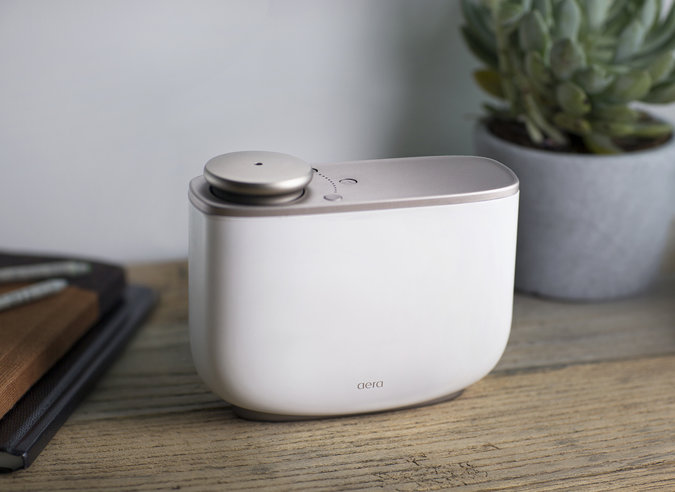Drugstores and other retailers are fully stocked with low-cost home fragrances, from room sprays to candles and wall plug-ins. Now, thanks to Air Esscentials and other such firms, there are options on the higher end: compact yet high-powered diffusers that will infuse scent throughout a room for hours or days at a time.
Examples include Aera, a $200 device the size of a paperback book that its parent company, Prolitec, says can perfume a room of up to 2,000 square feet, with fragrance levels adjustable through an app. Each fragrance capsule costs $50 and, according to Aera’s website, will last about 60 days if it is placed in “a 450-square-foot room, on an average setting running for 24 hours per day.”
Jeanette Wolfe, a holistic health educator, is a big fan of such devices and a big believer in the power of scent to increase energy and “drop you into a calm place,” as she put it.

She used to rely on old-fashioned methods to perfume her Victorian home in Princeton, N.J.: dried flowers and squares of muslin that were infused with essential oils and placed in the air vents. “But it wasn’t as strong or clear or efficient a scent as I wanted,” Ms. Wolfe said.
Now each floor of the house has its own fragrance dispersed by an AroMini, one of several styles of cold-air diffusers for the home made by AromaTech. According to the company, AroMini, a 12-inch-tall cylinder that costs $279, is strong enough to imbue fragrance in a 1,000-square-foot room. The essential oil or aroma oil refills cost $16 to $180, and last about a month.
Citrus, typically a combination of mandarin and bergamot, wafts through the first floor of Ms. Wolfe’s home, while frankincense and sandalwood perfume the bedrooms on the two upper levels. And to get rid of the “old house” smell of the basement, Ms. Wolfe favors “grounded scents” like evergreen, pine, mint and spearmint. “But I change them seasonally,” she said. “I’ll add spices during the holiday season. I’ll shift them if I’m having a dinner party. I’ll shift them depending on my mood.”
The home fragrance market is a $6.4 billion business at the retail level, according to a 2016 study by Kline, a market research and consulting firm in Parsippany, N.J. Using data from a Simmons national consumer survey, the online research company Statista calculated that 73 percent of Americans used room deodorizers and air freshener sprays last year; the figure is poised to hit 77 percent by 2020.
Advertisement
Continue reading the main story
More than just a way of eliminating odor (we’re talking about you, Fido and Frisky), home fragrance has lately become a means of self-expression. “It’s an element of design, like the colors on the wall or the furniture — it’s a way for people to communicate who they are,” said Richard Weening, chief executive of Prolitec, the Milwaukee-based commercial air care company that recently introduced Aera.
“I do not think I’ve met an individual who doesn’t respond to scents,” Ms. Wolfe said.
Actually, some don’t respond well. Consider the people who are allergic to perfumes or just don’t like them. The “fragrance free” movement, which uses the tagline “think before you stink,” has tried for years to beat back the use of fragrances in public places, in deference to the scent-sensitive.
Newsletter Sign Up
Continue reading the main story
Thank you for subscribing.
An error has occurred. Please try again later.
You are already subscribed to this email.
Still, there are many who consider lemon-infused air to be a luxury, maybe even a necessity. “The general principle is: People like places that smell good, and they don’t like places that smell bad,” said Mr. Weening of Prolitec.
To hear him tell it, the conventional tools deployed for making a place smell good — candles, sprays, wax melts, reed diffusers, and so-called liquid electricals like plug-ins — leave something to be desired. The scents are heavy, inconsistent and, in his view, maybe just a bit unrefined. “It’s that New York taxicab smell,” Mr. Weening said.
Two years ago, Dimitri Gailit, the chief executive of AromaTech, based in Vancouver, British Columbia, noticed that his company was fielding calls from clients who wanted their residences to smell as inviting as their stores.

“So we decided to make every one of our products available for home use,” he said.
The devices, sold through the company’s website and Amazon, include the AromaCube ($30), a battery-operated diffuser meant for a small space like a bathroom; the AromaPod ($129), designed for up to 500 square feet; and the industrial-strength AromaPro ($849), which comes with an HVAC adapter, meaning it can work through a customer’s home heating and air-conditioning system.
The company’s cold air diffusion process breaks down aroma oils and essential oils — the most popular are white tea and thyme, and oriental garden — and disperses them in the form of dry vapor.
Depending on the device, customers can digitally adjust the intensity of the vapor as well as the hours that it is dispersed. Control of the diffusers via an app is in the planning stages.
“There are people who are buying our machines for aromatherapy,” Mr. Gailit said, “and then there are customers who want to create a certain ambience in their home, like when they’re having a party. They may be having a tropical-themed party or a chocolate fondue party, so they’ll disperse a fragrance like coconut spice or chocolate.”
Advertisement
Continue reading the main story
Customers have responded, Mr. Gailit said: “Since we introduced our consumer line, we have significantly increased our business.”
Mr. Weening said he had had the same experience since Aera hit the market. “We’re way ahead of where we expected to be with sales,” he said. “People are buying multiple machines.”
Aroma360’s clients are mostly commercial, “but a lot of business owners asked for scents in their home as well,” said Meghan McMahon, the company’s director of marketing. Residential customers can choose from cold air diffusers that range in price from $149 (for 300 to 800 square feet) to $1,499 (to cover up to 6,000 square feet).
ScentAir, too, ventured into the home fragrance market at the urging of commercial customers. But rather than sell directly to the consumer, ScentAir has made its home fragrance system — which is essentially a high-end plug in that costs $130 — available exclusively on the websites of hotel clients like Marriott and Westin.
“It’s a nice tie-in for us,” said Edward Burke, ScentAir’s vice president of customer strategy and communications. “And by offering the home version on the hotels’ websites, it helps us be a better partner.”
Continue reading the main story
Article source: https://www.nytimes.com/2017/08/02/business/smallbusiness/commercial-fragrance-systems-home-market.html?partner=rss&emc=rss
Speak Your Mind
You must be logged in to post a comment.